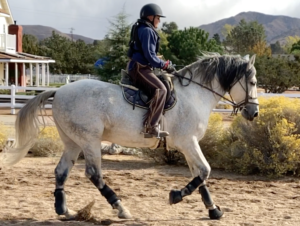
INTRODUCTION
The purpose of this article is to explore how the components of good horsemanship have sharpened my ability as a dog trainer. This, in turn, can be of great benefit to owners who wish to rely on my expertise to train their dogs..
What are those components, you may ask, and how could they apply to dogs since dogs and horses are so different? One is big the other small; one is predator the other prey; one has eyes in front of the head, the other has them to the side. Though these differences are very real, there are similarities beyond the fact that both species have four legs and a horizontal view of reality — — similarities which when identified and appropriated for one’s work with these creatures, can be of great benefit.
There are four things common to both dogs and horses . Firstly, both dogs and horses operate within a social structure of hierarchy. Hierarchy is what they understand and is their point of reference when functioning with other individuals in their group —–and, I would argue, with humans. Secondly, though both dogs and horses will gladly eat treats out of your hand, this practice can work against your relationship with them. Thirdly, Awareness is necessary when working with both dogs and horses. I am defining awareness in its most basic form as an ability to be present with the animal and notice what s/he’s communicating to you. Finally, work with both dogs and horses requires strength of will or courage from the handler along with ability and the timing to apply it quickly.
But there is more. the handler must be interested in his/her subjects, indeed have a passion for them. Without a passion for the creatures you’re working with, you won’t apply the necessary attention and understanding to the development of the partnership between the two of you. Along with this, the handler must be willing to read the non-verbal body language of the animal to know what the creature is saying without words and be comfortable with that.
My most recent experience with horses has been with my beloved PRE stallion Soñador. Though he is now deceased, our work together lives on in my sharpened my abilities to work with dogs as well as horses: Through my work with him, I have gained a better understanding of hierarchy, the necessity of staying away from hand-fed treats when training animals, the importance of a laser sharp awareness, and an ability to respond with courage, ability and timing.
Let me explain.
UNDERSTANDING HIERARCHY
IN GENERAL
Hierarchy is defined as a system or organization in which individuals are ranked one above the other according to status or authority. Individuals in a hierarchy understand that group members are either leaders or followers and that rules and boundaries govern the relationship between those members.
WITH HORSES
Horses in herds, much like dogs in packs, organize their social structure according to hierarchy. That is, there is the alpha male and alpha female with other members falling below these based on their own status and authority in the herd..
The alpha male gains his status according to his willingness and ability to control other members of the herd. This control will manifest in the stallion’s physically being able to move members of the herd both individually and as a group. An extreme of this behavior is called “snaking” where the stud will lower his neck, bar his jaws, and menacingly rush toward a would-be challenger or intruder.
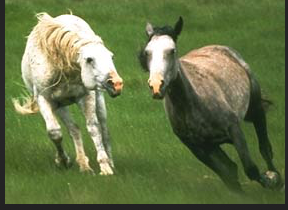
A strong alpha male is critical to the herd’s survival. Being prey animals, the alpha will span the boundaries of the herd’s position to sight potential intruders, warn the herd away from a dangerous situation, or take on the intruder himself to protect the herd. And he is formidable in these tasks. My coach, Joel Sheridan, once told me he had occasion to observe a wild stallion grab the skids of a helicopter endeavoring to take off that was being used to corral his herd.
The alpha will find grazing spots for herd members and is the only male privileged to mate with the mares. He may at times be challenged by the younger, fitter males and must be ready to prove his worth.
Because of the stallion’s role as leader, all stallions are hard-wired for dominance. Human beings must therefore be ready and able to respond to the inevitable challenges stallions will put towards them to determine whether or not the human is a worthy leader of the stallion.The human handler must put him/herself in the role of the new stallion able by skill and reason to show the testy male that s/he is qualified to dominate.
For example, just as the stallion might move members of the herd around, now I move him. This happens astride, of course, but for purposes of the analogy of horse training to dog training, relevant control of the horse’s body would take place on foot through work in a roundpen and leading. A roundpen is an enclosed circle of approximately 50+ feet in diameter. It has been used for literally thousands of years to train horses from the ground.
In the roundpen, the stallion is moved at the different paces — walk, trot, canter — and asked to change direction frequently. By making such requests of the stallion, the handler is asserting his/her dominance by being able to control the stallion’s movements.
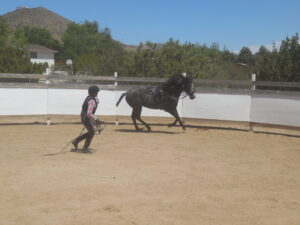
The horse understands this because this is what he would do to members of his own herd.
Still, the stallion may be prone to assert his dominance in other forms of groundwork such as leading. An example is when he might use his body to try to push the handler or turn and face her as if to challenge. Through these experiences, I have had to learn to be quicker and more aware than my stallion so that I am ready to apply a consequence for the pushy behavior.
And the consequence must be fair. It can’t be too weak or too late lest the stallion see you as a fool who can be taken advantage of.
The question which remains is this: Does the human leader/handler have the will to control her strong male equine partner? This is the question my able coach David Johnston put to me when we first began working together with Soñador. You have to want to do it, Dave told me; you have to be willing to take the steps necessary to show your stallion you are his leader, not the other way around.. And I have found in all the years I’ve been working with my stud horse that I have had to continue to want to do it. Without a strength of will stronger than my stallion’s, all the skill and awareness in the world won’t work for me.
WITH DOGS
The reader may remember from my article Obedience Training Dogs; The Best Way that much like the male stallion, the alpha male dog in a pack will move other members of the group around as one way to establish his dominance. Such dominant behavior will include bumping, blocking, moving in between the human and other dogs, standing alert with the tail held high (a sign of confidence), low growling whenever another dog comes near, or making eye contact and holding it.
So too the dog trainer recognizes this and models her behavior accordingly. I have learned from work with my stallion that I can move my alpha dogs around much as I would move Soñador around in the roundpen. I have become the alpha of my pack at home by making all the decisions for the pack: I eat first, go through the door first, determine which dog gets attention and when it is given, sit and sleep in the prime spots, “move” a pack member out of my way instead of walking around or stepping over her.
KNOWING WHY TRAINING WITH TREATS IS TO BE AVOIDED AND WHAT THE TRUE REWARD REALLY IS
WITH HORSES
“No blade of grass has ever run from a horse. Do not use food as a reward.”
Monty Roberts
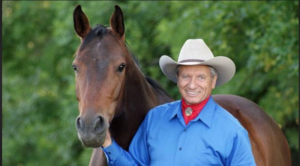
What Monty means here is that because horses are herbivores, grass is not something that must be hunted or chased down. It is available on the ground for them to eat. So food is not a tool they use with each other to manipulate behavior; neither should we.
He goes on.
“Treats are, in my opinion, the best method in the world to train a horse to do one certain behavior: It is the best method of training a horse to bite their handler. Have a look at the clicker trained horses fed treats and you will witness an enormous group of equine individuals who consistently bite their handlers.”
I have been a follower of Monty Roberts for many years. His claim to fame is a non-violent method of horse training he developed as a counterpoint to the violent methods used by his father. He discusses this in his landmark best seller The Man Who Listens to Horses. Other books by Monty include Horse Sense for People and From My Hands to Yours. I studied with Monty some years ago and achieved my Certificate of Basic Horsemanship from the Monty Roberts International Learning Center in Solvang, California, also known as Flag is Up Farms.
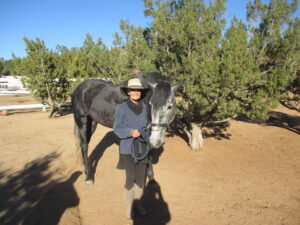
One of the first things I remember Monty doing while I was at the Learning Center was using exercises to help horses develop trust in humans instead of hand feeding them with treats as an incentive to obey.
Trust is an essential component of the horse/human partnership because in the eyes of the horse, we are predators who present a clear and present danger to him much as a crouching lion. We after all have eyes in front of our heads just like the big cats, not to mention the reputation we have accumulated for abusing them, eating them and exploiting them.
To help the wild horses, the ruined horses, and the rescues get over their distrust of humans Monty and his staff used touch in the context of deliberate routines to show them that the human was not to be feared but rather could be relied on as a haven of safety, shelter, and companionship.
I remember one such exercise where a young wild horse was placed in a shoot so he couldn’t hurt himself or anyone else. Then one by one the staff and students took turns petting him on the neck until he relaxed. Petting, a caress, and kind words excelled in their power to develop trust in the horse way beyond any treat given by hand.
We also worked with the horses in the roundpen to educate them on how proximity to the human being and listening to his/her requests was a safe and indeed enjoyable place to be. We learned how to create meaning for the horse so he could safely and enjoyably enter our world and we his.
Armed with this education, I have never hand-fed my horses, particularly my stallion. Stallions have by nature a tendency to nip and bite. So hand feeding them can have disastrous consequences in the form of biting or attacking the handler for the treat that in his mind is rightfully his.
WITH DOGS
Because I have been highly sensitized to the negative consequences of hand feeding horses, I naturally steered away from the use of treats when working with dogs.
This practice was reinforced by Don Sullivan‘s training methods in which I have been schooled. By applying Sullivan’s methods, I have become convinced without a doubt that training dogs using hand-fed treats as a reward can have negative consequences just as it does for horses but for different reasons.
Dogs are predators who must hunt and chase down their food. Canine members of a pack who are lower in stature will give up their food as a sign of fealty to a member with higher stature. Food given by hand from a human is thus viewed by a dog as an admission by the human of his/her inferior status. How confusing then it must be for the dog when his so-called leader assumes a position of inferiority by hand feeding him while at the same time giving him a command to do something.
As with horses, the most powerful reward I have found with a dog is the human touch, caress and kind words. Yet I often think we are much too busy and preoccupied to take the time to do this. It’s so much easier to just shove a treat in a dog’s mouth. And he seems so eager to get it. Yes, but it doesn’t establish the respect we need from our dogs, and it often doesn’t work. I have thought of training with treats as the TV dinner method of dog training or the assembly line method. How much faster it is and thoughtless.
What we’re after from our dogs is respect, not acquiescence to get a cookie.
HAVING AWARENESS
Once I understood how horses and dogs operate within a context of hierarchy, I wanted to explore how this predisposition is expressed non-verbally. This is where awareness comes in.
A key ingredient necessary to successfully train stallions or puppies for that matter is awareness. The handler has to in fact be aware that an animal’s activity is building into a misbehavior in order to successfully correct it.
THE EYES TO SEE
Awareness is simply knowing what the information coming at you from another creature means . This sets you up for responding to it in a way that has positive and productive consequences for the partnership as a whole.
I have learned from my stallion that being acutely aware of his body language and what that language is communicating to me is critical to my responding as an effective leader. For example, in the roundpen, his ear on me shows he’s listening; licking and chewing shows he has a mind to cooperate; ears back and a shaking of the head reveal resentment or an attitude of challenge.
Similarly, my dogs have shown me that ears back and a tail between the legs is an attitude of suspicion; standing still and staring down another dog shows dominance with the staring dog about ready to pounce on the more compliant member.
There are different components to awareness.
NOTICING BEFOREHAND
WITH HORSES
To notice beforehand means knowing what to expect and watching for it. This takes experience and training and above all being alert in the present. You can’t be thinking about what to have for dinner.
Soñador has shown me this in spades be it noticing his anger, compliance, curiosity, or contentment.
The other day I was riding him and walking him down a path on my property that abuts a neighbor’s yard. Right next to the fence that divides the two properties on the neighbor’s side are some stalls with horses in them. I have been by here many times before. But this time was different. There was a new mare in one of the stalls, and she was nickering in that “come hither” tone as Soñador and I walked by. Soñador began to respond by arching his neck, prancing, and nickering. I urged him gently forward, and we made it through.
I thought about this afterwards and realized that this is one of those instances where noticing beforehand comes in handy in order to prepare your horse for what’s coming and what will be required of him in kind.
My coach Joel Sheridan had some thoughts about this: He said one must first indeed prepare; that is, one must anticipate what’s coming and prepare your horse so you don’t end up pouncing on him at the last minute with a correction and making things worse. He suggested flexing Soñador’s head in the direction of the mare before you get to her, which he wants to do anyway, but then using the leg to yield him a bit away. So he is doing some work which the rider requires but in a way which takes his sensibilities into consideration.
Sometimes you can’t always prepare the horse in that fashion but must rather act quickly and decisively.Either way, one must be willing to allow one’s attention to be captured by the event the animal is bringing to you.
With stallions the stakes are much higher than with dogs. If you don’t read the behavior correctly and act on it quickly, you can be hurt or in some cases killed. As a result, my antennae have become acutely sensitized to the silent but direct signals my stallion sends me and by transference, my dogs.
WITH DOGS
Don Sullivan tells a story about teaching his clients how to correct their dogs pulling on the leash . He explains to his clients simply that whenever the leash becomes taught, the client will know that his/her dog is pulling and that it is time to correct the behavior with a short, sharp tug on the line.The line or leash is connected to Sullivan’s Command Collar designed to replicate a mother’s bite on the neck of her pup if he misbehaves.
Sullivan will ask his clients something to the effect
“Do you understand when your dog is pulling and how to correct it?”
The client answers,
“Oh, yes, Don. I understand.”
Then Sullivan explains that the client and dog will get no more than half way to their car when he is compelled to shout out,
“Your dog is pulling,”
The client after telling Sullivan that he understood perfectly when his dog was pulling on the leash and how to correct it, proceeds to his car totally oblivious to the fact of his dog doing just that. The client has not in fact developed the noticing beforehand component of awareness to know when the dog is pulling or not. In this case, we might say that the client hasn’t developed the feel for it.
INSIGHT
But there is another component to awareness besides noticing (knowing) beforehand.
It is insight. Merriam Webster defines “insight” as the capacity to gain an accurate and deep intuitive understanding of a person or thing. It’s the eyes to see clearly what’s going on inside another; When I say “clearly,” I mean free of one’s own preconceived biases and ideas which can blind one’s vision of what’s really happening. Has the dog been abused? Spoiled? Is s/he suspicious? In despair?
What you See Comes From Inside You
Seeing outside oneself into the state of another emanates from inside the onlooker. Let me give you a couple of examples.
- If a puppy pees when and where you don’t want him to, do you see a disobedient cur deserving of the harshest punishment or a youngster that is physically incapable of holding it up to a certain age?
- When you hear about horse fighting in the Philippines or dog fighting in the United States, do you see a way to indulge your bloodthirst to make money, or are you horrified at this provoked cruelty?
- When you see skin-and-bones street dogs in Egypt, Turkey or India, do you see a way to make money in the dog meat trade of the wet markets or a downtrodden creature in need of rescue?
Some of what we see is culturally conditioned. Some of it comes from experience, and some of it comes from upbringing and sophistication. More of it comes from empathy, that God-given gift that emanates from a deep love of the creature that informs our vision.
Education is a factor. Going back to the example of the peeing puppy, an educated response would understand that puppies are physically incapable of holding their pee up to a certain age.
I have sensed despair in dogs along with questioning and confusion. This sensibility was and continues to be honed through my work with my stallion. I ask myself when is he trying, or has he had enough and it’s time for me to back off. When is he becoming frustrated so it’s better to moderate the activity and come back another day to try again? These are questions which inform my insight that I must ask myself when working with my stallion.
They are the same kinds of questions which inform my insight when working with dogs.
PUTTING COURAGE TO WORK AND THE TIMING TO DO IT QUICKLY
Once I understood hierarchy, honed my commitment to train without treats, and have developed my awareness, I must now act. With my stallion, I have learned that the action must be immediate, in the right way with the right equipment, and in the right measure. There are three components to this: Courage, ability, and timing.
COURAGE
I talked about courage above in the sense of being willing to make a correction when needed with resolve. This does not mean an absence of fear. Courage for me means recognizing the fear and working through it armed with ability.
ABILITY
WITH HORSES
“The Most Important Equipment in Horse Training is the Hands That Hold the Reins.” Monty Roberts
The correct equipment must be chosen for the occasion and the horse.
Then after that, whether it’s a snaffle or curb bit if you’re riding or a plain rope halter, leather halter with chain nose band, Dually with cloth noseband , or seretta with iron noseband if you’re leading, it is the knowledge for when and how to apply pressure which is most important.
It takes ability to respond in the proper measure in the right way.
“The response must be sharp to make him think you can hurt him more than he can hurt you. If not sharp and immediate, you could frustrate him, make him mad or communicate you’re not serious. Either way, he can take advantage of the situation, and things can get decidedly worse.”
“If you correct him in a half-hearted way, your actions will only make him mad, and he’ll jump on you and do serious damage. Physically, you aren’t capable of really hurting a big, mature stallion. When you discipline him severely, initially he’ll be surprised and shocked by your aggressiveness.”
The above remarks were made by stallion handler Marv Walker in response to questions having to do with the correct response towards a pushy, aggressive stallion.
But a sharp, tough correction is not always on order.The correction must be proportional to the offense. You can also make a stallion mad, or any horse, by being too rough when the stallion didn’t deserve it. It’s about justice.
WITH DOGS
The Most Important Equipment in Dog Training is the Hands That Hold the Leash
The correct equipment must be chosen for the occasion and the dog. Then after that, whether it’s a Command Collar or a prong collar, the most important issue is to act with feel.
I remember my first walk at a dog rescue with a large, aggressive dog and correcting his pulling on the leash with a tug on his collar. This tug clearly outweighed the pull the dog was giving me He showed his displeasure with my disproportional response by turning towards me and barking loudly. This required another correction by me which could have escalated into an ugly dog/human confrontation but fortunately didn’t. I was able to calm the dog down, assess my transgression and start over. It’s about justice.
TIMING
“The discipline must be done immediately so the stallion associates the bad behavior with the discipline. It must done quickly so he’ll know he’s being disciplined and what he’s being disciplined for.”
“If the discipline lasts longer than a few seconds, he’ll realize you really aren’t hurting him that bad and the fact that you are ‘trying’ to discipline him will tee him off big-time. You’ve now shown him how physically weak you are, and he’ll make you pay the price. You must end the discipline while the stallion is still in the initial shocked phase. If you don’t, you could find yourself on the ground with one of your arms torn off.” Marv Walker
WITH HORSES
The response must be immediate. The pictures below show what can happen when that is not the case. What is pictured is an escalating situation in the early years of Soñador’s training where my timing was incorrect.
It began with Soñador crowding me into a corner. The first problem is that I was not aware of what he was doing. Secondly, instead of sharply and quickly backing him off with slaps of my rope underneath his chin (a technique I have since learned), I went for meek dribbles with my whip here, there, and everywhere —-absolutely ticking this stallion off because the taps had no meaning for him. The result was that the stallion turned and faced me, with me doing more weak taps with the whip. Finally, Soñador went on the attack by coming at me. For some reason, he stopped and backed off, a move for which I was deeply grateful. Coach Dave Johnston rescued the situation by coming over and showing me where I erred. I learned my lesson, and nothing like this has happened since.

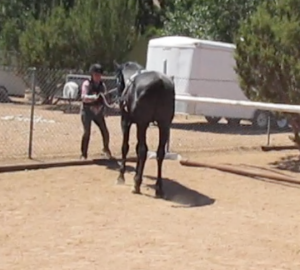
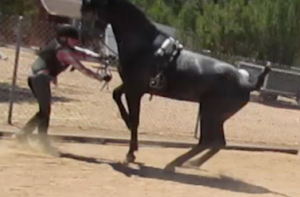
The picture below shows the opposite response of Soñador when he is handled correctly. He is walking calmly beside me on a relaxed lead line.
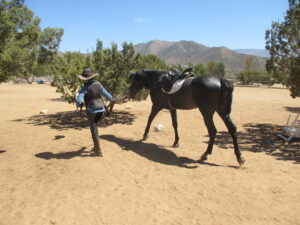
WITH DOGS
From my experience with Soñador, I have learned that an absence of correction given to a dog who is pulling on the leash, for example, though not life-threatening, will result in the dog continuing to pull on the leash and a deterioration of respect for his/her handler.

If not sharp and immediate, you could frustrate your dog, make him mad or communicate you’re not serious. Either way, he can take advantage of the situation, and things can get decidedly worse as shown above.
In contrast, the videos below show me walking my dog Lula properly on the leash. This is the result of an application of correct training methods and consistent work with Lula since she was a puppy. Quite the opposite of the picture above and reminiscent of my quiet walk with Soñador.
WHY IS THIS IMPORTANT?
It’s about justice.
“Animals have a very heightened sense of justice. They know instinctively that certain actions cause certain reactions. By the same token, an unjust action would offend the animal’s sense of justice. We as humans start justifying degrees and motives, and then justice becomes murky. In animals, justice is cut, dried, and accepted.” (Marv Walker “Dealing with Horse to Human Aggression,” www.marvwalker.com)

In this article, I have discussed skills necessary in good dog training which have become sharpened through work with my P.R.E. Stallion Soñador.
I’d love to hear your views. Please leave a comment below. Also I encourage you to read other articles on this site and have a look at the Services page for ways I can help you with your dog.
REFERENCES
Roberts, Monty, The Man Who Listens to Horses, Random House, New York, 1996
Roberts, Monty, From My Hands to Yours, Monty and Pat Roberts, Solvang, CA, 2002